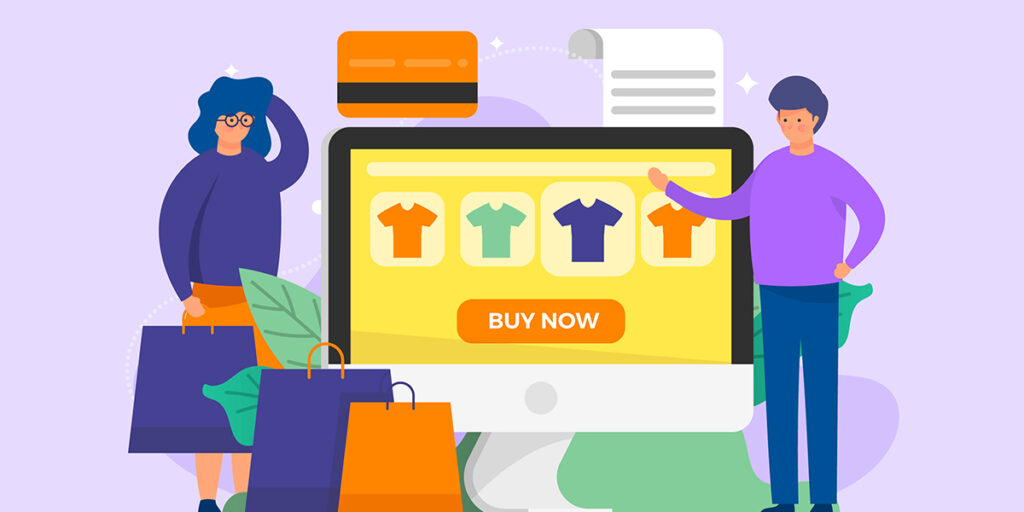Today in the digital era, when consumers have so many choices available to them at the click of a button, e-commerce firms need to go a step beyond normal.
Personalization has become the key weapon for personalization by enabling the online retailers to tailor shopping experiences to individual customer preferences. With enriched data, AI, and advanced analytics, customer satisfaction can be improved, engagement enhanced, and sales increased. This article discusses what personalization is all about in e-commerce, its prominence, various strategies, advantages, and obstacles, as well as its future in the e-commerce market.
The Importance of Personalization in E-commerce
E-commerce personalization is no longer a luxury; it has become an expectation. Epsilon’s research reveals that 80% of consumers are more willing to buy from brands providing a personalized experience. Personal product suggestions, dynamic pricing, and customized email marketing campaigns greatly optimize the customer journey and enhance conversion rates.
Consumers today demand content, products, and promotions relevant to them. The traditional one-size-fits-all solution does not work today, with customers today anticipating that the brand will understand their shopping and purchasing behaviour. Personalization enables companies to engage their audience on a more intimate level, thereby developing customer loyalty and retention.
Key Strategies for E-commerce Personalization
Personalizing e-commerce offers a great deal in performance optimization by improving user experience, engagement, and conversion rates. Supporting this, businesses will leverage artificial intelligence and analytics to bring personalized shopping experiences that will enhance customer satisfaction and loyalty.
Product Recommendation
The AI recommendation engine is used to analyze the customers’ data and suggest some products of interest. This online marketplace is equipped with state-of-the-art technology to evolve shopping suggestions and product comparisons, including mobile phones, televisions, laptops, tablets, and other tech gadgets. By using AI insights from previous purchases and browsing history, these recommendations help boost customer engagement, increase average order value, and encourage repeat purchases by showing customers what they’re most likely to buy next.
Dynamic Website Content
Dynamic websites have the ability to change content on-the-fly in accordance with user actions; product listings, home-page banners, and promotions can all be customized to provide a more targeted shopping experience. If customers view products that are relevant to their interests, they are likely to visit the site for longer and ultimately make their purchases, enhancing conversion rates. A custom web development company can tailor dynamic websites to match specific business needs, integrating advanced features like AI-driven recommendations, personalized user experiences, and seamless backend management
Behavioral Targeting and Retargeting
User behaviour is monitored to form customer segments and provide personalized marketing initiatives. For instance, retargeting strategies involve advertising and emailing customers with reminders of the products they have previously browsed, with a view to improving conversion rates. Targeted ads according to their interests are presented across various platforms to assist businesses in re-engaging potential consumers, thus reducing cart abandonment rates and thus enhancing revenues.
Tailored Email Marketing
Email marketing campaigns should be uniquely catered to each individual’s preference produce higher levels of engagement and conversions. Be it through customer recommendations, product reminders for a previously abandoned cart, or even exclusive deals that a customer alone receives, personalized subject lines and content theoretically improve open rates, while dynamic email campaigns are direct to keeping customers interested and coming back for more purchases.
Chatbots and AI-Powered Customer Support
AI-influenced chatbots provide customers with a direct response to almost every relevant inquiry. Whether it is recommending a product or answering frequently asked questions, overall, it has further streamlined customer support, thus making it possible for end-users to enjoy a user experience enriched by 24-hour availability, time-saving, and most importantly, personalized support when customers need it.
Customized Loyalty Programs
The best kind of loyalty programs is those that offer a benefit to consumers including their preferences that motivate them towards repurchase. Special discounts, personal incentives, and tailor-made promotions will keep a shopper talking. By way of highlighting each person’s buying patterns, a business can create the feel of exclusivity around one’s set of customers and use those experiences to boost customer retention and long-term brand loyalty based on meaningful, customized encounters.
Location-based Personalization
Geolocation technology enables all businesses to provide location-based deals and services. Recommending stores near, offering region-specific offerings, or modifying the availability of stock based on the region makes the shopping experience feel seamless in both online and offline channels. These actions will make shopping easier, make customers happier, and increase footfalls to physical stores.
Benefits of Personalization in E-commerce
A personalized experience makes the customer feel valued, consequently enhancing engagement and conversion. According to a McKinsey report, personalization can increase revenue by 10-15% based on providing relevant product recommendations and targeted promotions in line with customers’ preferences.
- Greater Customer Satisfaction
A personalized shopping experience helps customers find more relevant products quickly, thus facilitating their buying process. When buyers feel that they have been understood, they will enjoy seamless shopping, leading to higher satisfaction and a good image of the brand.
- Having Improved Customer Retention and Loyalty
When brands acknowledge a customer’s preferences, the customer feels inclined to come back. By providing personalized offers, recommendations, and special rewards, businesses can build a solid relationship with the customer, stimulating the latter to repurchase and maintain brand loyalty.
- Increased Average Order Value (AOV)
The process of personalization further encourages customers to browse different items and add complementary products to their cart. Thus, increasing their gross purchase value and maximizing revenue per transaction.
- Advanced knowledge of a customer
According to personalization, a business collects considerable data on customer behaviours and choices. These insights help companies refine marketing strategies, design targeted campaigns, and optimize the shopping experience for better engagement and sales.
Challenges of Personalization in E-commerce

If one thing can be said about personalization, it’s that it positively affects customer experience and sales; however, along with that come the intended and unintended challenges businesses must negotiate. Personalization brings with it a different set of challenges ranging from data privacy issues to different hurdles associated with implementation; thus, companies need strategic solutions to balance personalization with user trust and operational efficiency.
Data Privacy Issues
With strong and frequently changing regulations like GDPR and CCPA, businesses must act responsibly wherever customer data is concerned. Whenever businesses collect personal data, they should be transparent with customers on how their data is collected, stored, and used, as well as how consent is obtained. Working against the privacy of customers can have far-reaching effects in terms of legal penalties, reputational damage, and customer dissatisfaction; therefore, compliance with privacy regulations must become a priority.
Implementation Complexity
Establishing AI-driven personalization tools will require substantial investments in technology, infrastructure, and human resources. Small businesses might find these costly in both money and expertise to implement seamlessly. Poor integrating with already laid platforms and performance criteria can be a cost that some organizations might find difficult to meet.
Risk of Over-Personalization
Too much, too extreme personalization generates a feeling of modus for intrusion escalating discomfort among customers. They may not trust the brand when they feel excessively scrutinized. It is about right-on-target balancing act between relevance with privacy that makes customers feel valued instead of manipulated to this end preserving engagement long loyalty.
Inaccurate Data Issues
Personalization is only dependent on the data; the data, if inaccurate, old, or incomplete, will generate uninteresting recommendations, which will ultimately undermine user experience. Businesses must have robust strategies regarding data management and continuously update and validate customer information so that personalized experiences can remain meaningful, accurate, and aligned with customer expectations.
Future Trends in E-commerce Personalization

With modern advancing technologies, e-commerce personalization sophistication will grow to offer hyper-targeted experiences. AI, AR, and voice commerce are key in bringing in those super intuitive and engaging experiences in online shopping of the future.
- AI and machine learning advancements.
AI gets better in personalizing by predicting customer behaviors with greater accuracy. This would ensure that advanced algorithms analyze data in real-time, become efficient in recommendations, dynamic pricing, and automated customer support-all of which can make for a more seamless shopping experience.
Real-time data processing allowing ultra-personalization in businesses. The interactions can vary from push product notifications to marketing messages. Overall, it is enhancing customer satisfaction and better conversion rates because of personal insights brought by AI.
- Augmented Reality (AR) and Virtual Try-Ons
AR allows customers to experience products before their purchase through virtual try-ons across fashion, cosmetics, and home décor. It permits a browse-try-buy online environment, giving confidence to reduce the rate of returns.
- Personalized Voice Commerce
With the adoption of voice assistants, e-commerce platforms will use voice recognition to personalize the shopping experience. Through AI-powered voice searches, such personalized recommendations will make shopping much more comfortable and interactive.
Conclusion:
The new e-commerce paradigm of personalization provides an opportunity for all businesses to interact with their clients on a personalized level. The use of artificial intelligence, analytics, and new marketing techniques offers retailers the tools to develop personal experiences that help drive sales, loyalty, and satisfaction. However, companies face the challenge of balancing personalization with issues of data privacy and ethical concerns. With the advancement of technology, the future of personalization in e-commerce is capable of much more dynamism; therefore, businesses should always remain flexible and revise their plans continuously in order to stay ahead in the race.